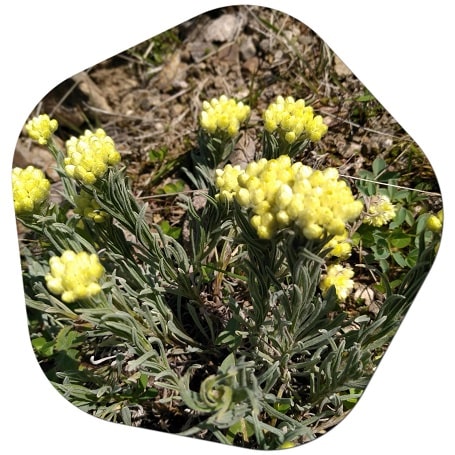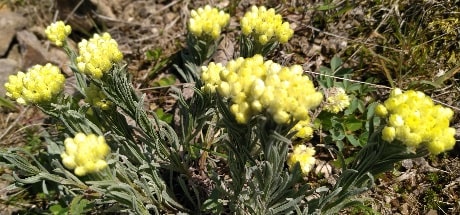The English name for Helichrysum arenarium is “Everlasting” or “Sand Everlasting.” It is a flowering plant in the Asteraceae family and is commonly known for its dried flowers, which retain their shape and color even after drying, making them popular for decorative purposes.
Where does Helichrysum arenarium grow? Helichrysum arenarium, commonly known as Sand Everlasting or Everlasting, is native to various parts of Europe, including Central and Eastern Europe. It is found growing in sandy or gravelly habitats, such as sand dunes, dry meadows, heathlands, and rocky slopes.

Specifically, Helichrysum arenarium can be found in countries such as Turkey, Russia, Poland, Germany, Lithuania, Latvia, Estonia, Belarus, Ukraine, Romania, and Bulgaria. It prefers well-drained and nutrient-poor soils, often thriving in regions with a continental climate. In addition to its native range, Helichrysum arenarium has been naturalized in some other countries, including parts of North America. It has been introduced to certain areas where it has adapted to the local conditions and is cultivated or found growing in the wild.
What zone is Helichrysum Arenarium in?
Helichrysum arenarium, commonly known as Sand Everlasting or Everlasting, is typically classified as a plant suitable for USDA hardiness zones 3 to 8. However, it’s worth noting that hardiness zone ranges can vary depending on specific environmental conditions and sources of information.
In general, Helichrysum arenarium is well-suited to regions with a temperate climate. It can tolerate colder temperatures in zone 3 and can also thrive in zones 4 to 8, which cover a wide range of areas across North America, Europe, and other regions with similar climates.
It’s always recommended to consult local gardening resources or experts to obtain precise information on the suitability and specific hardiness zones for growing Helichrysum arenarium in a particular location.
What is the habitat of Helichrysum arenarium?
Helichrysum arenarium, commonly known as Sand Everlasting or Everlasting, is typically found in sandy or gravelly habitats, particularly in dry and nutrient-poor environments. Its natural habitat includes the following:

- Sand dunes: Helichrysum arenarium is well-adapted to grow in coastal areas with sandy dunes. It can tolerate the harsh conditions of shifting sands and high levels of salt exposure.
- Dry meadows: It is commonly found in dry grasslands or meadows with well-drained soil. These meadows are often characterized by low fertility and limited moisture availability.
- Heathlands: Helichrysum arenarium can be found in heathlands, which are typically open, low-nutrient environments with acidic soils. These areas are often dominated by shrubs, grasses, and low-growing plants.
- Rocky slopes: It is known to grow on rocky slopes or outcrops, where it can adapt to nutrient-poor soils and rocky substrates. These habitats often provide good drainage and exposure to sunlight.
Helichrysum arenarium has a preference for habitats with low fertility, good drainage, and relatively dry conditions. It is well-suited to thrive in regions with a continental climate, characterized by warm summers and cold winters. What is the common name for Helichrysum arenarium? >>
What is another name for Helichrysum?
Another name for Helichrysum is “strawflower.” The name “strawflower” refers to the dry, papery texture of the flower petals, which can retain their shape and color even after drying. This makes them popular for crafting, dried floral arrangements, and other decorative purposes. The name “strawflower” is commonly used for various species within the Helichrysum genus, including Helichrysum bracteatum, which is known for its vibrant and long-lasting flower heads.
